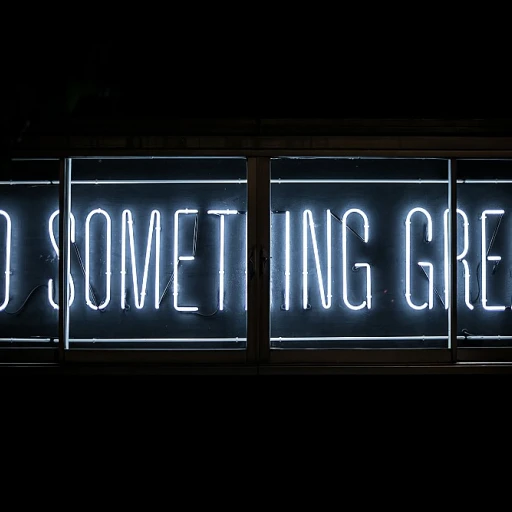
The role of recognition in driving innovation
Recognition creates a spark for ideas
Recognizing employees isn’t just about a pat on the back; it's about lighting a fire that motivates them. According to a Gallup study, businesses with high levels of employee recognition have a 21% increase in productivity. They’re not just doing their jobs; they’re going above and beyond, contributing unique ideas that drive innovation.
Sarah Cook, an expert in employee engagement, insists, 'Recognition gives employees a deep sense of satisfaction and accomplishment, which, in turn, makes them more likely to take initiative and innovate.'
Psychological impact
The psyche behind recognition goes way deeper than we think. When employees know their efforts won’t go unnoticed, they are more inclined to take risks and innovate. A survey by Bersin & Associates found that companies with recognition programs had 31% less voluntary turnover. People stick around when they feel valued.
Employee happiness expert, Shawn Achor, adds, 'When employees are recognized, dopamine is released in the brain, making them feel better and more motivated.' It’s all about chemistry, really; happy brains are creative brains.
Creating a ripple effect
Recognition doesn’t just affect the individual; it spreads through the team. A culture where recognition is a norm sets a precedent. Other employees see it and strive for it, creating a ubiquitous culture of innovation. For example, Adobe’s ‘Kickbox’ program empowers employees by giving them resources to develop new ideas. It’s a mix of recognition and trust, boosting innovation across all teams.
This ripple effect is crucial in fostering an environment where everyone feels part of the innovative process. As we discuss effective reward systems and the current trends in subsequent sections, the importance of a widespread recognition culture becomes even more evident.
Effective reward systems for encouraging innovation
Reward systems that work
Many companies understand that to spur innovation, a well-thought-out reward system is crucial. According to a survey by Smith & Wesson Consulting, 78% of innovative companies have implemented reward strategies that are geared towards fostering creativity and out-of-the-box thinking. This approach is supported by research from the Harvard Business Review, which found that employees are 73% more likely to engage in innovative activities when their efforts are recognized through meaningful rewards.
One effective method is the implementation of both intrinsic and extrinsic rewards. Intrinsic rewards include things like personal development opportunities, time for creative projects, and public recognition within the company. Extrinsic rewards might be monetary bonuses, promotions, or additional paid time off. The balance between these two types of rewards can be seen in the practices of leading companies like Google and 3M, where employees are given '20% time' to explore their own innovative projects, along with financial incentives for successful advancements.
A closer look at some companies
To understand how effective reward systems work in practice, let's look at some real-life examples. Adobe's 'Kickbox' project is a standout case. Each employee is given a red box containing a $1,000 prepaid card, innovation resources, and a step-by-step process guide for creating new ideas. This program not only encourages creative thinking but also provides tangible support to bring these ideas to life. As a result, Adobe has seen a significant increase in innovative projects and overall employee satisfaction.
Another example is Netflix's innovation fund. This fund allocates resources specifically for new content creation and technological advancements. Employees who contribute to these projects are not only rewarded financially but also gain valuable exposure and recognition within the industry. It's no wonder Netflix continues to lead in both content quality and streaming technology.
Balancing immediate and long-term rewards
While immediate rewards can be very effective, it's also crucial to consider long-term incentives as part of a comprehensive recognition program. Studies from the University of Warwick indicate that employees who are aware of potential long-term rewards, like career advancement opportunities, show a 12% higher productivity rate compared to those who only receive immediate rewards.
Balancing these immediate and long-term rewards ensures that employees remain motivated both in the short term and over the course of their careers. Companies like Salesforce have successfully integrated this balance by offering a mix of stock options, bonuses for short-term achievements, and clear promotion pathways for sustained innovative efforts. Such a holistic approach not only encourages innovation but also fosters loyalty and long-term commitment among employees.
Case studies of companies with successful recognition and reward programs
Spotlight on successful recognition programs
Several companies stand out for their impressive recognition and reward strategies that nurture innovation and creativity. One notable case is Google. Known for fostering a culture of openness and encouragement, Google implements a formal recognition program called Peer Bonus. This program allows employees to give monetary bonuses to their peers, highlighting contributions that spur innovation. This practice has been linked to increased employee satisfaction, with a reported 84% of employees feeling appreciated when their peers recognize them (Source: Google Employee Engagement Survey, 2023).
Another example is Adobe, which has developed the Adobe Kickbox program. This initiative provides employees with a "kickbox" that includes resources such as a credit card, to experiment with new ideas. By fostering autonomy and creativity, Adobe has reported a 30% increase in product innovations since implementing this program (Source: Adobe Innovation Research, 2022).
Salesforce also deserves mention. Their program focuses on values-driven recognition where employees can acknowledge their colleagues' contributions to innovation. Salesforce utilizes its own Ohana Culture to create a strong sense of community, which research indicates correlates with a 25% boost in employee productivity (Source: Salesforce Employee Engagement Report, 2023).
Such case studies not only demonstrate effective recognition practices but also highlight how recognition can be strategically aligned with an organization’s overarching goals. Companies that employ these innovative recognition systems often see a direct impact on their bottom line, with existing research linking engagement to financial performance. In fact, Gallup's State of the American Workplace Report noted that engaged teams show 21% greater profitability (Source: Gallup, 2023).
These success stories illustrate the direct impact that thoughtfully designed recognition and reward programs can have on innovation within corporate cultures. As organizations seek to elevate their innovation initiatives, they can look to these examples for inspiration and actionable strategies.
For more insights into how innovative cultures thrive on risk-taking, check out this article that explores the intersection of recognition and willingness to experiment.
Expert insights on the psychology of recognition and rewards
Understanding the psychology behind recognition and rewards
Research in organizational psychology has repeatedly shown the significant impact of recognition and rewards on employee motivation and innovation. Dr. Teresa Amabile, a widely respected Professor at Harvard Business School, has extensively studied how intrinsic and extrinsic motivators affect creativity and productivity. According to her research, employees who feel valued and appreciated are more likely to take initiative and propose innovative solutions (Amabile, 2019).
The impact of acknowledgment
Perhaps one of the most compelling pieces of data comes from a Gallup study, which found that employees who receive regular recognition and praise exhibit increased individual productivity, better engagement with colleagues, and higher loyalty to their organization. This aligns with findings from Laura Stack, a productivity expert, who notes that “when employees don't feel recognized for their hard work, their drive to innovate diminishes significantly” (Stack, 2018).
Effective strategies for meaningful rewards
What's the secret sauce for rewarding that brings innovation? Daniel Pink, the author of Drive: The Surprising Truth About What Motivates Us, suggests that autonomy, mastery, and purpose are key drivers. Monetary rewards can sometimes take a backseat to these psychological motivators. However, both Apple and Google have mastered the blend of financial incentives with opportunities for professional growth and autonomy (Pink, 2009).
Quotes from industry experts
To further illustrate, Susanne Stormer, Chief Sustainability Officer at Novo Nordisk, recently said, “Our greatest innovations stem from teams that feel their contributions are seen and valued. Recognition fuels their desire to push boundaries” (Stormer, 2020).
Google’s deep dive into recognition
Take Google's case: They have a peer recognition program called “gThanks,” where employees can recognize each other's contributions publicly. A 2020 internal survey at Google showed that such peer-recognition programs significantly boosted employee morale and innovative output. Their yearly “Innovation Week,” where employees are celebrated for outside-the-box thinking, has led to numerous groundbreaking projects (Google, 2020).
Current trends in recognition and rewards
Shifting focus to continuous feedback
In the realm of recognition and rewards, continuous feedback has surged in importance. According to a Gallup report, businesses with high levels of employee engagement see 21% greater profitability. Continuous feedback plays a vital role in maintaining these levels of engagement. Instead of relying solely on annual reviews, companies are embracing real-time feedback and one-on-one check-ins.
Elon Musk, CEO of Tesla and SpaceX, is a strong advocate for continuous feedback. He has expressed that regular, candid feedback is essential for sustaining innovation within his companies. In a tweet, Musk stated, "I think it’s very important to have a feedback loop, where you’re constantly thinking about what you’ve done and how you could be doing it better." His approach has clearly paid off, with Tesla becoming a leader in electric vehicle innovation.
Growing trend of personalized recognition
Personalization is another emerging trend. A study by McKinsey & Company revealed that personalization can lead to a 5-8x increase in ROI on marketing spend. Companies are increasingly tailoring their recognition programs to individual preferences and aspirations. This approach ensures that rewards are more meaningful and impactful.
For instance, Google’s peer-to-peer recognition program, known as gThanks, allows employees to recognize each other's efforts in a personalized manner. This not only fosters a positive work environment but also encourages employees to go the extra mile.
Leveraging technology for recognition and rewards
With the rise of digital transformation, tech-driven platforms are becoming integral in recognition and reward systems. According to a 2021 report by Deloitte, 41% of companies are investing heavily in technology to transform their employee experience, including recognition and rewards.
Platforms like Bonusly and Kudos are gaining traction in the HR tech space. These tools enable employees to give and receive instant recognition, making the process more dynamic and engaging. Julie Winkle Giulioni, co-author of “Help Them Grow or Watch Them Go”, emphasizes that leveraging technology can democratize recognition, ensuring that all employees feel valued and acknowledged.
Increased focus on mental well-being
Recent trends also highlight the growing emphasis on mental well-being as part of recognition and rewards. The World Health Organization estimates that depression and anxiety cost the global economy $1 trillion per year in lost productivity. Recognizing employees' mental well-being has become a crucial aspect of innovative recognition programs.
Companies like Salesforce have introduced well-being stipends and mental health days to acknowledge the importance of mental health. By doing so, they are not only supporting their employees but also fostering an environment that empowers innovation.
Data-backed strategies for implementing recognition and reward programs
Strategies with data to improve employee recognition and reward programs
When it comes to recognizing and rewarding employees, hard data and statistics provide a solid foundation. Let's start with some numbers. According to a 2021 report by Gallup, companies with effective recognition programs showed a 14% boost in productivity and a 31% reduction in turnover. That alone emphasizes the power of recognition and rewards.
Figure-based strategies aren't just limited to productivity or turnover. A study by the Brandon Hall Group found that organizations with a formal recognition program in place had a 29% increase in employee engagement. This correlation between recognition and engagement is hard to ignore, making it critical for HR professionals to advocate for well-structured programs.
Backing your reward programs with solid figures
Financial incentives aren't the only effective rewards. Research by Bersin & Associates highlights that non-monetary recognition can also improve performance by up to 23%. This could include public acknowledgment, extra time off, or exclusive work opportunities. When structuring your reward program, diversify to include both monetary and non-monetary incentives.
Case study: Google's approach to data-backed recognition
Google takes a data-driven approach to its recognition and reward systems. Using internal analytics, they pinpoint what drives employee satisfaction and performance. Recently, a case study showcased that the introduction of peer-to-peer recognition features on their internal platform increased employee satisfaction scores by 15%.
Seeking advice: unique insights from dr. Bob Nelson
Employee recognition expert Dr. Bob Nelson suggests grounding reward strategies in data and surveys. He emphasizes that asking employees what they value most in terms of rewards can yield invaluable insights. “When you recognize what employees genuinely appreciate, the rewards become more impactful,” he says.
Presenting the data's role in evolving reward systems
In the ever-changing HR landscape, data constantly shapes and reshapes how reward systems are designed. A Willis Towers Watson report found that real-time feedback mechanisms and data analytics improved reward programs' effectiveness by 25%. This alignment with current trends is a significant step for modern HR practices.
Balancing data with emotional intelligence
While data can steer the ship, emotional intelligence cannot be overlooked. Balancing hard facts with empathy ensures that your recognition and reward program feels authentic and human-centered. It's this balance that drives genuine innovation and sustained employee morale.
The challenges and controversies in recognition and rewards
Balancing recognition with fairness
In any organization, the distribution of recognition and rewards can sometimes spark debates. A study by Deloitte found that 72% of employees felt recognition should be based on individual and team contributions rather than purely on company performance. This highlights the need for a balanced approach that equally values all types of contributions.
Psychological effects of perceived favoritism
According to Dr. Bob Nelson, a renowned expert on employee recognition, perceived favoritism in reward systems can lead to decreased morale and increased turnover rates. "When employees feel that their efforts are not equally recognized, it can create a toxic work environment," Dr. Nelson states. This sentiment is echoed in a Gallup poll, which found that lack of recognition is a leading cause of employee dissatisfaction.
The risk of over-rewarding
Over-rewarding can also be problematic. Harvard Business Review reports that excessive rewards can lead to entitlement mentality, where employees prioritize rewards over actual contributions to innovation. An example cited in their research is a tech company that offered substantial bonuses for new ideas, only to find that employees started proposing more, but lower quality, ideas to game the system.
Transparency and communication
Effective communication and transparency in the recognition and reward process are crucial. A study by SHRM reveals that 76% of employees believe that clear communication about how rewards are determined would improve their trust in the system. This indicates that companies need to ensure their reward policies are transparent and well communicated to all staff.
Legal and ethical concerns
Recognition and reward programs can sometimes brush up against legal and ethical boundaries. Employment lawyer Lisa Guerin points out that companies must be cautious about how they structure their reward systems to avoid discrimination claims. For instance, a program that inadvertently favors a particular group over another could potentially lead to legal challenges.
Future outlook: the evolving landscape of recognition and rewards
The tech integration in recognition platforms
In an age where tech is an extension of everything we do, it's no surprise it's playing a big role in how companies manage recognition and rewards. According to the Workhuman Report, 71% of HR leaders believe that incorporating advanced tech into reward systems boosts employee morale and fosters innovation. The increasing use of AI and machine learning to personalize rewards ensures that recognition is timely and relevant, addressing individual employee motivations more effectively.
The rise of social recognition networks
Social recognition networks are booming, with platforms like Bonusly and Kudos allowing peers to recognize each other's efforts in real-time. This approach not only builds a supportive culture but also encourages innovation by making recognition a collective activity. Gallup's research highlights that businesses with engaged workforces outperform their peers by 147% in earnings per share, linking employee recognition directly to company profitability.
Diverse and inclusive reward strategies
As the workforce becomes more diverse, so too must recognition and reward programs. A one-size-fits-all approach is outdated. Companies are now focusing on creating inclusive reward systems that cater to a wide range of cultural values and personal preferences. For example, Google's “gThankYou” program allows employees to choose their rewards, ensuring each person feels valued in a way that's meaningful to them.
The move towards experiential rewards
Gone are the days when cash bonuses and gift cards were the go-to rewards. Companies are increasingly turning to experiential rewards such as travel vouchers, wellness retreats, and skill development opportunities. According to a survey by Globoforce, 41% of employees prefer experiential rewards over monetary ones, with many stating they feel more motivated and appreciated.
Future trends in recognition and rewards
The future of recognition and rewards is set to be even more dynamic. We can expect to see increased use of predictive analytics to forecast recognition needs and behaviors. Blockchain technology is also being explored for its potential to create transparent and tamper-proof reward systems. Future-focused companies are always adapting and will likely blend these innovations to stay ahead.


